There might be a tree here. 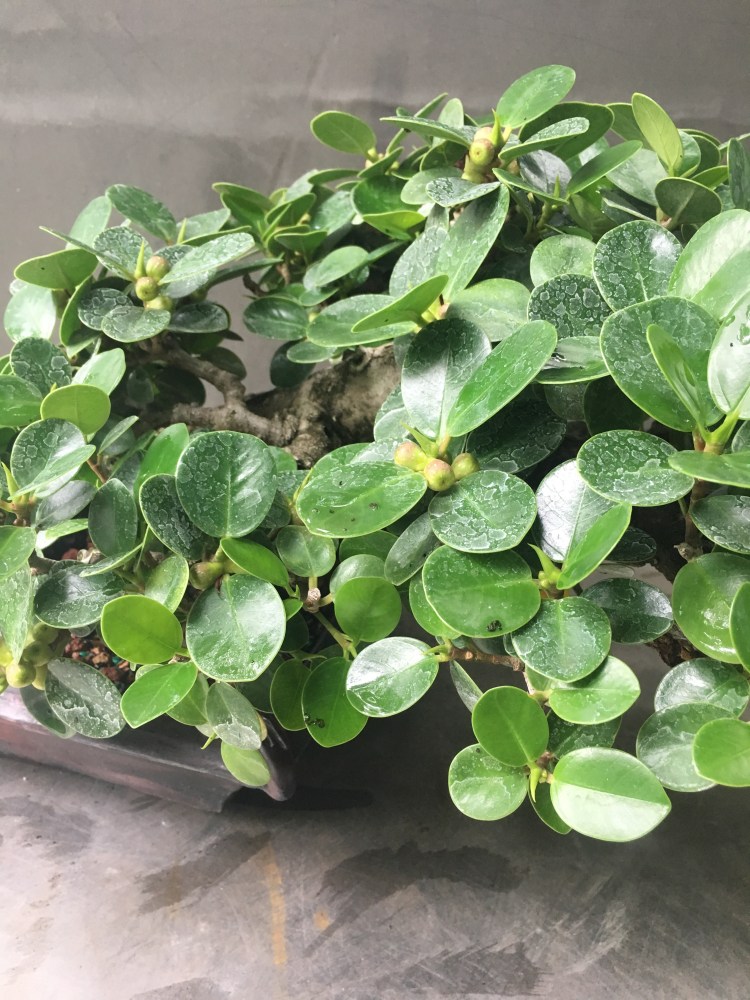 Underneath the leaves, somewhere.
Underneath the leaves, somewhere. 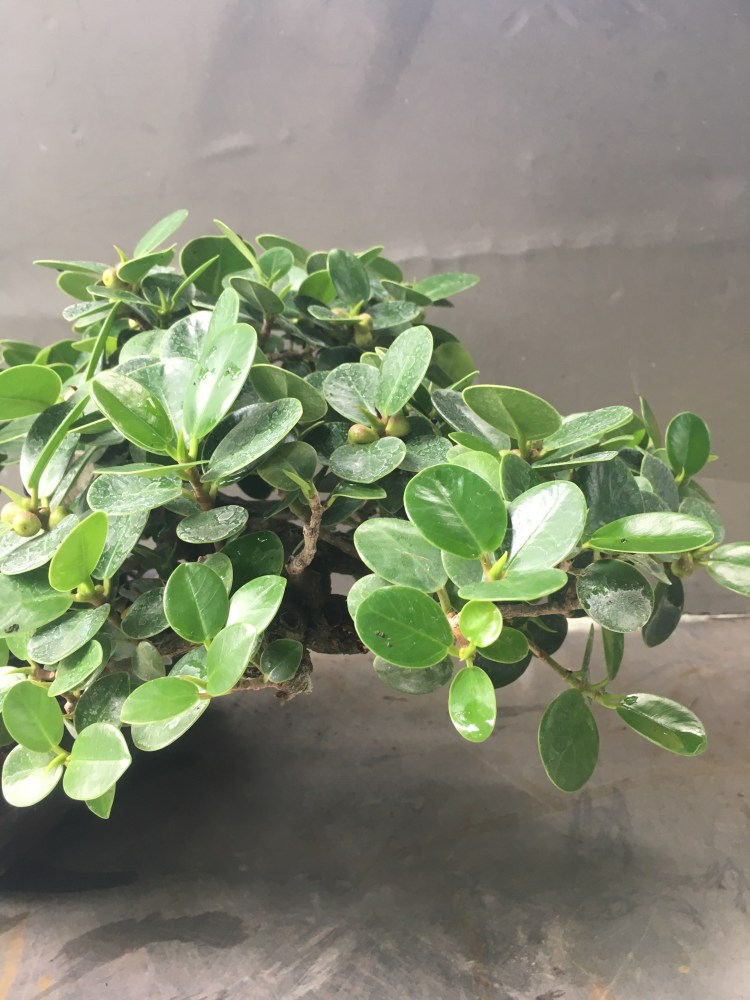 Maybe.
Maybe.  But I do believe it’s time for the scissor.
But I do believe it’s time for the scissor.  Let’s see what’s underneath.
Let’s see what’s underneath.
Ah, I see a trunk. 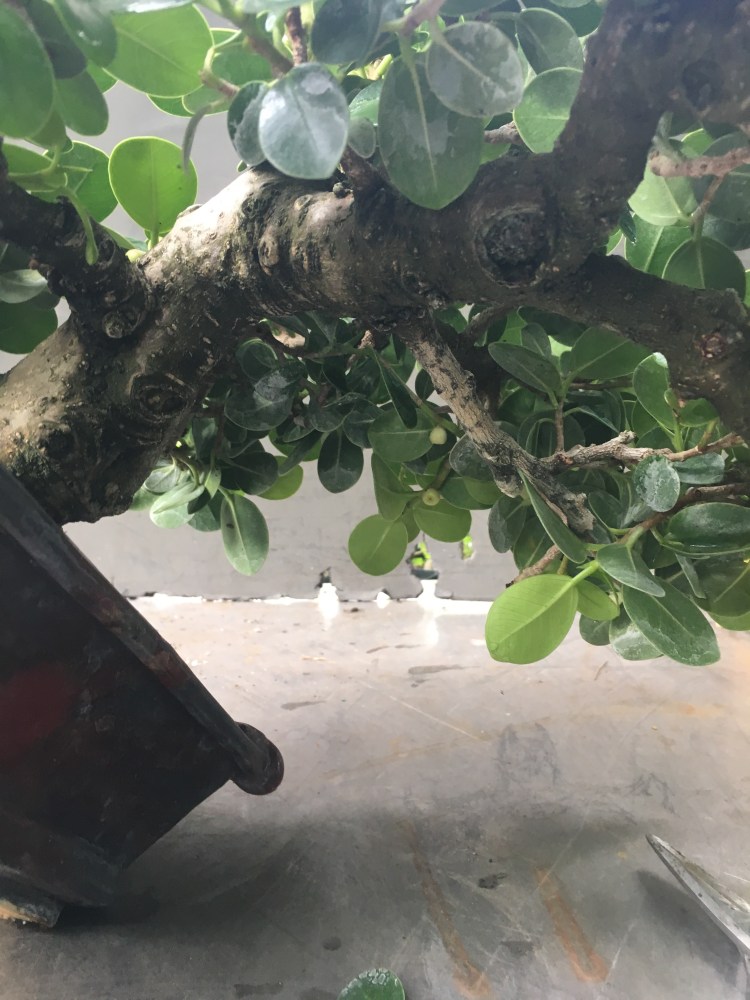 We might have a bonsai here, instead of a bush. Not that a bush is bad…..
We might have a bonsai here, instead of a bush. Not that a bush is bad…..
There are even some branches. 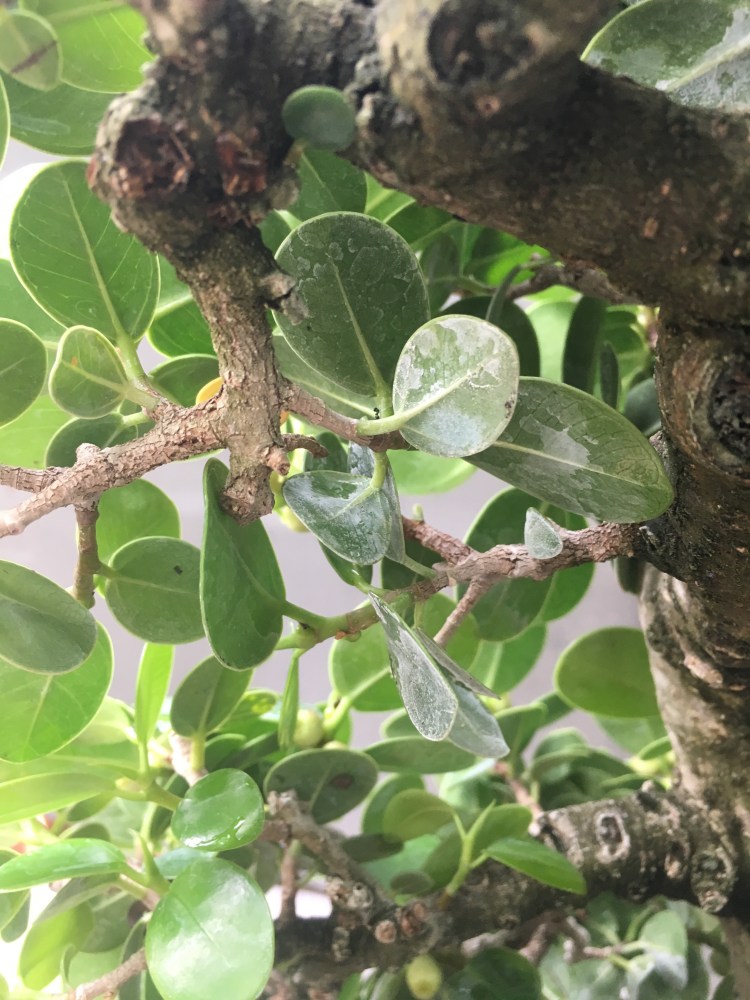 Yup. Uh huh.
Yup. Uh huh.  Movement too.
Movement too.
Sometimes I feel like a sculptor with a hammer and chisel, chopping out the superfluous. Like here. Three branches from one spot. That’s the easy first step, cut out one.
That’s the easy first step, cut out one.  I love these challenges. I’m going to do the work as I usually do it, branch by branch.
I love these challenges. I’m going to do the work as I usually do it, branch by branch.
First, I get rid of these….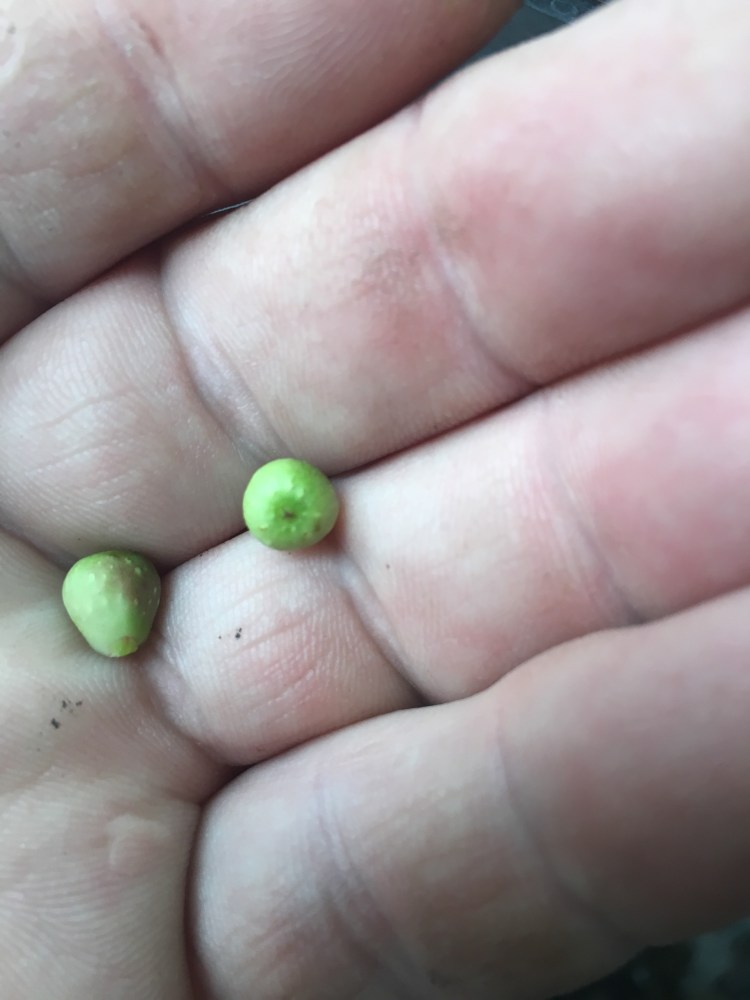 ….singularly, they’re called “syconium”, more than one are called “synconia”. Latin is weird sometimes. I was called out once about the plurality or singularity of the word. Bonsai people are funny.
….singularly, they’re called “syconium”, more than one are called “synconia”. Latin is weird sometimes. I was called out once about the plurality or singularity of the word. Bonsai people are funny.
This tree is a ficus microcarpa “green island”. A ficus is a fig, a fig is a ficus, so most people mistake these round, fruit-like thingies as figs. But they won’t be figs until they become pollinated, usually by a specific wasp. So now we will call it a synconium, which the official definition is: a fleshy hollow receptacle that develops into a multiple fruit, as in the fig.you could call it an inflorescence, a modified stem, some even think of it as a kind of bract. Hell, you can call it a potentiality followed by an actuality. Anyway you think of it, consider this a combined entomological, etymological, and botanalogical lesson for the day. You’re welcome.
Continuing forward, I clear out the multiple branches and defoliate the old, damaged, and shaded out leaves. I keep the growing tips (stipules, if you would) and the last one or two leaves.  Aha! Here’s a good example of multiple branching from one point. There are three.
Aha! Here’s a good example of multiple branching from one point. There are three. 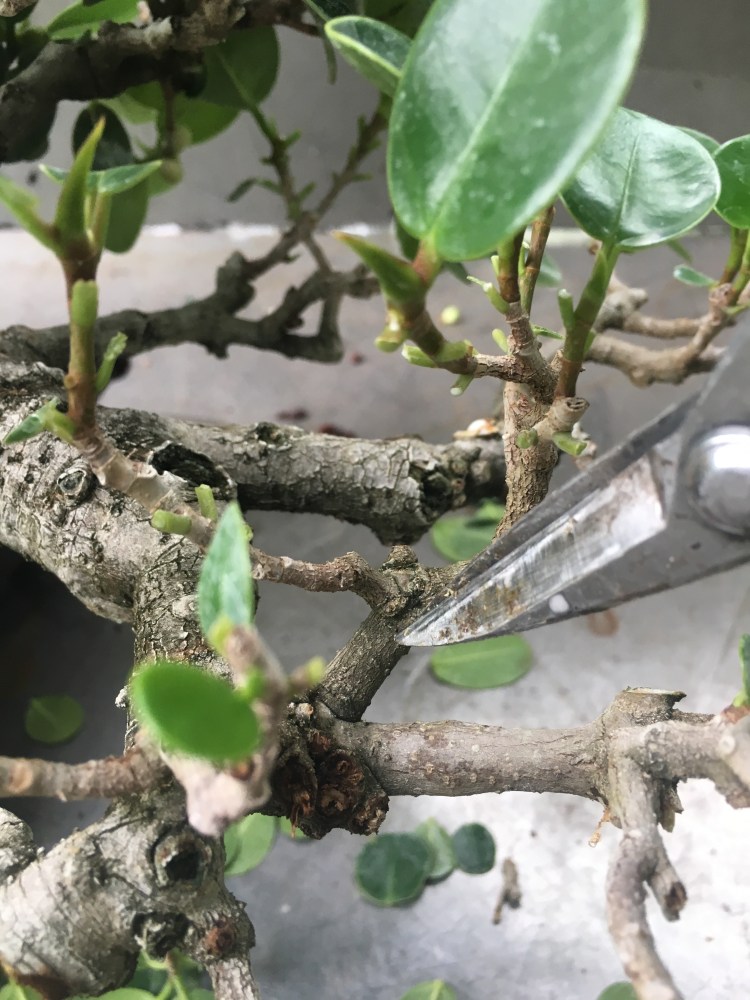 I haven’t figured which one I want to keep yet, give me a minute.
I haven’t figured which one I want to keep yet, give me a minute. 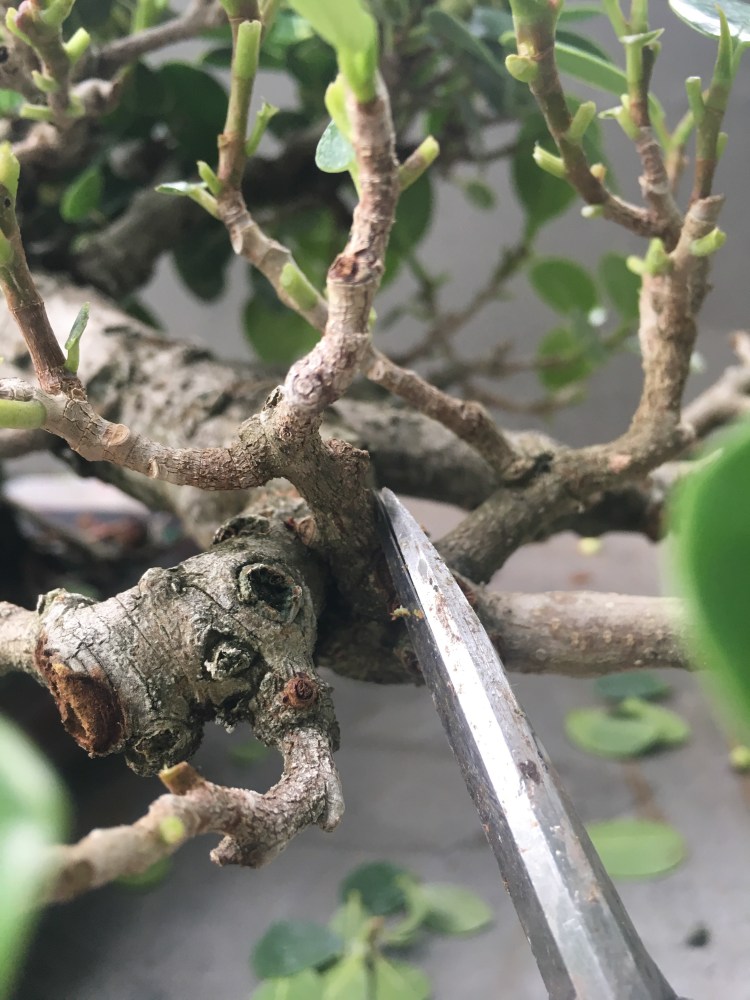 This one above is a definite removal
This one above is a definite removal
And the one going back, and that’s it. 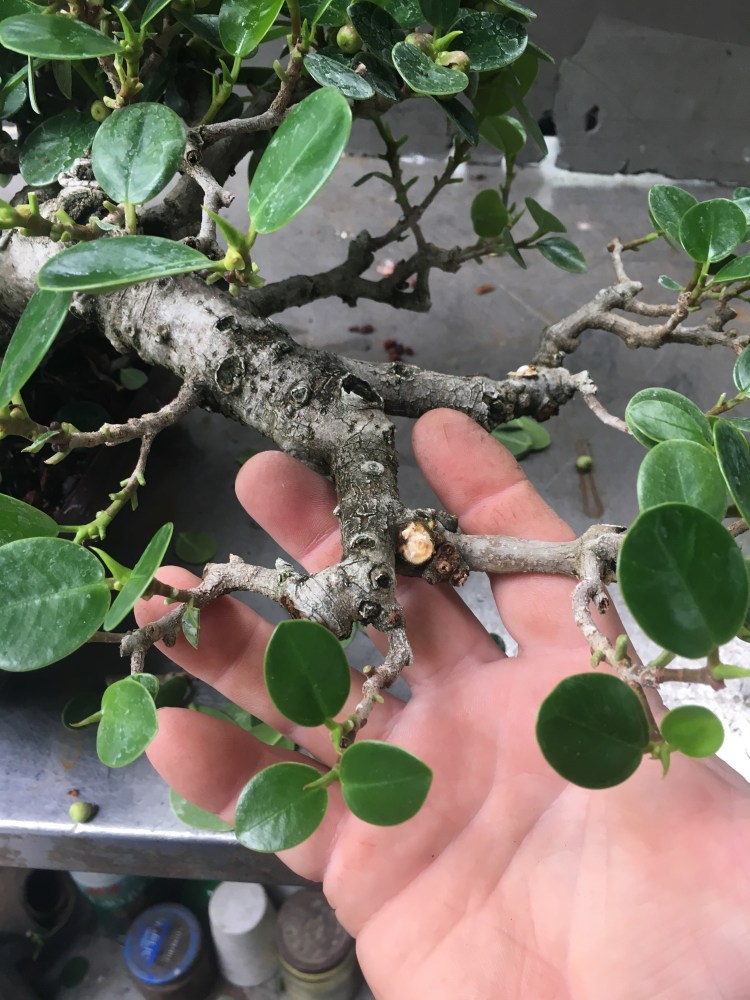
I often will keep younger branches and get rid of older ones, for the vigor and flexibility the younger ones offer.  But in this case, I don’t need it.
But in this case, I don’t need it. 
Here’s a choice to be made. Do I keep this to wire over the top?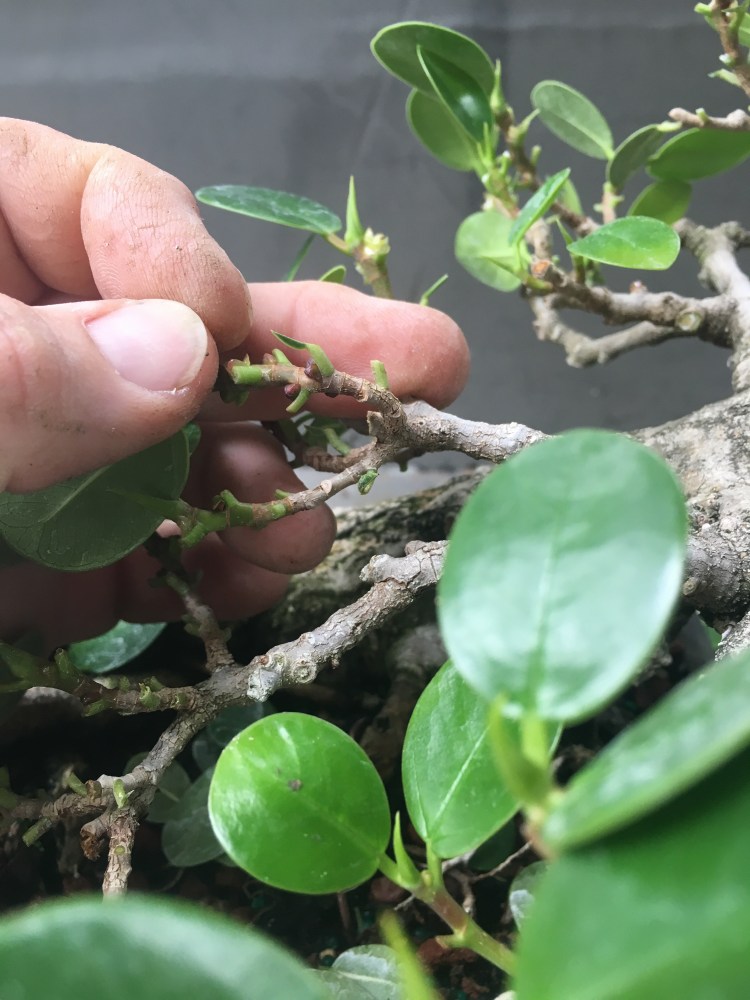
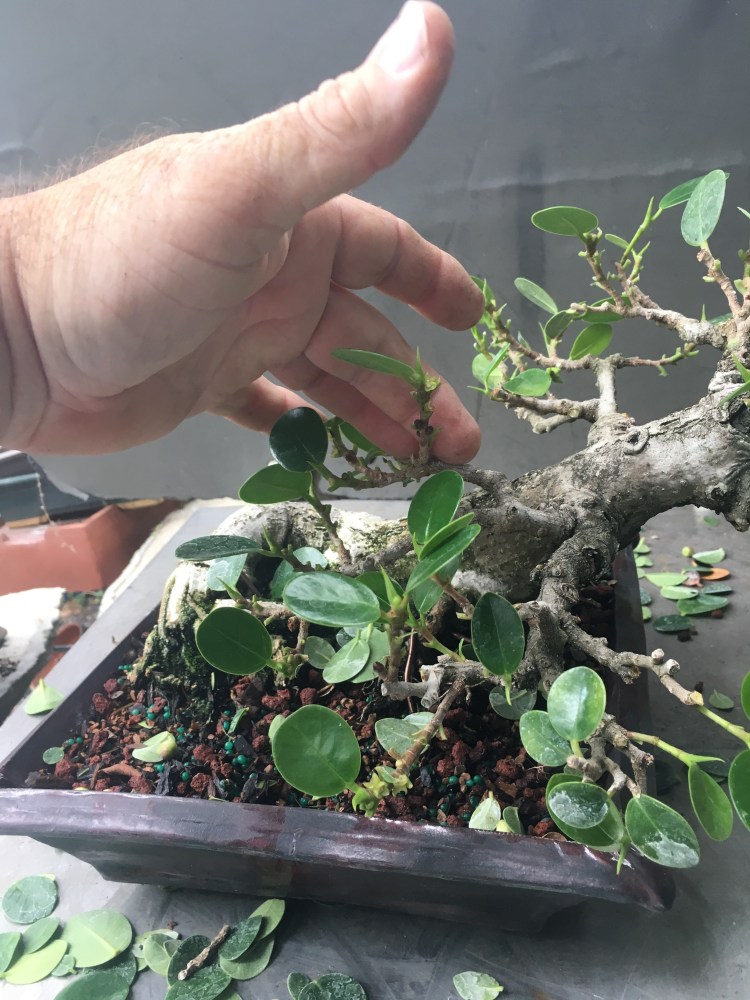 Or get rid of it?
Or get rid of it?  I think it goes. The first level needs help.
I think it goes. The first level needs help.
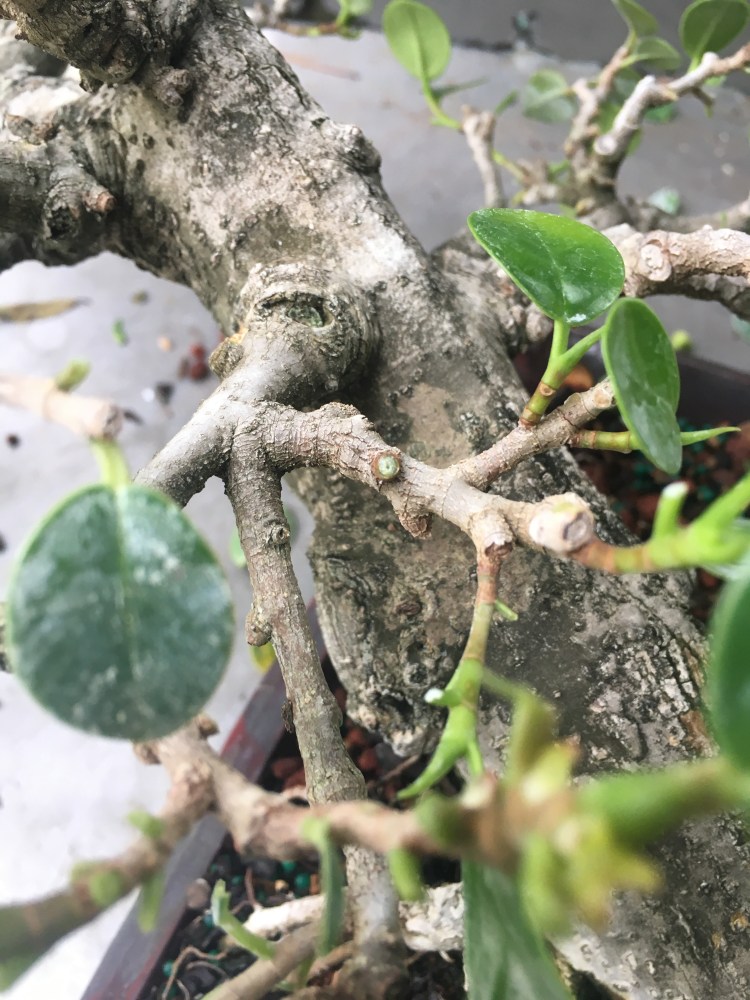 Continuing…
Continuing…
I think that’s good for the moment. 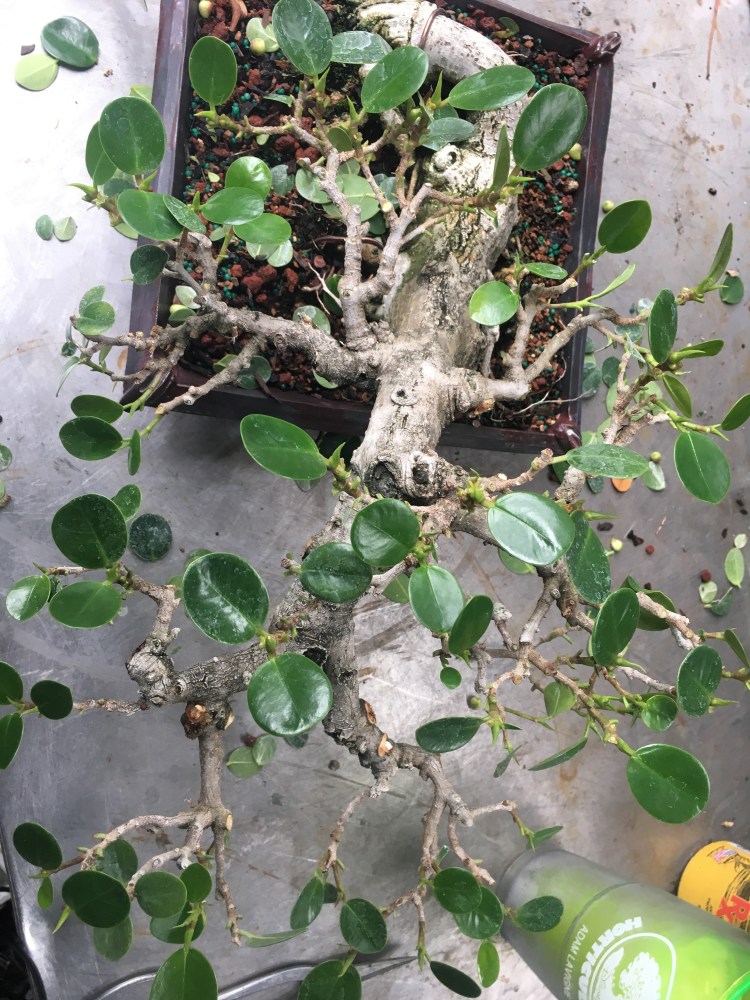 Notice I didn’t cut any tips yet? I’ll get to that. Now we need a new angle of attack, I think.
Notice I didn’t cut any tips yet? I’ll get to that. Now we need a new angle of attack, I think. 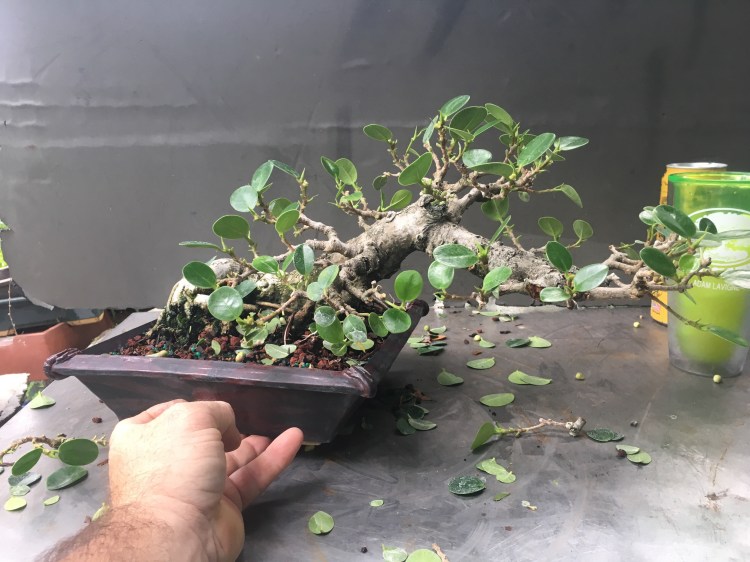
Let’s look at the roots. 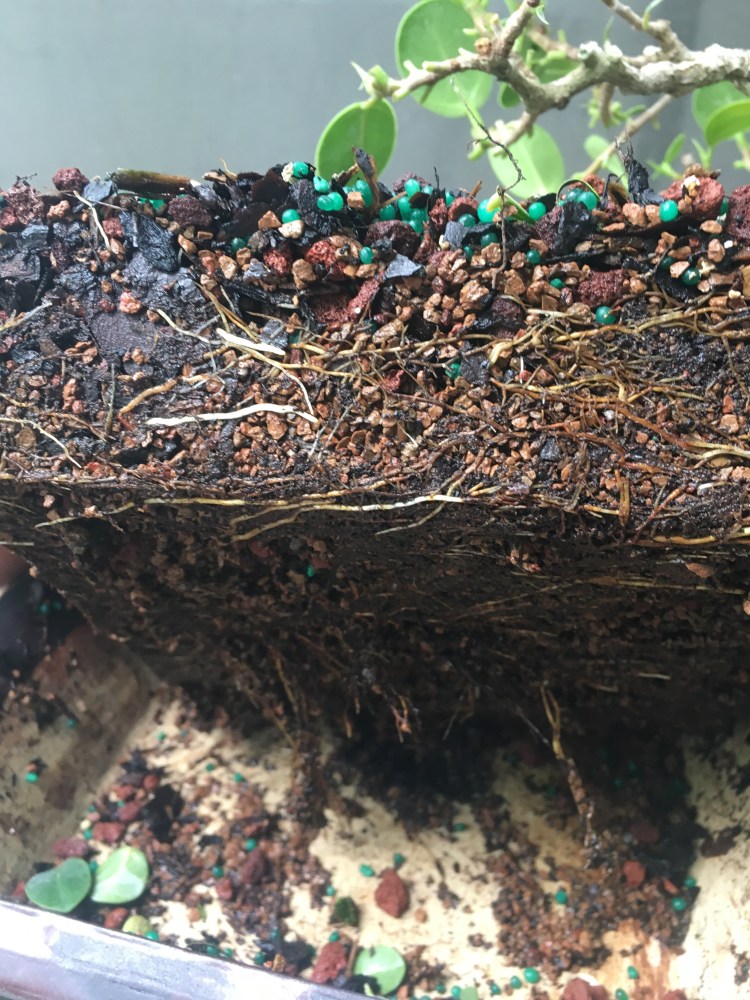 It doesn’t need a repot per se, but I can adjust the angle a little. A change of view almost always changes your view……
It doesn’t need a repot per se, but I can adjust the angle a little. A change of view almost always changes your view……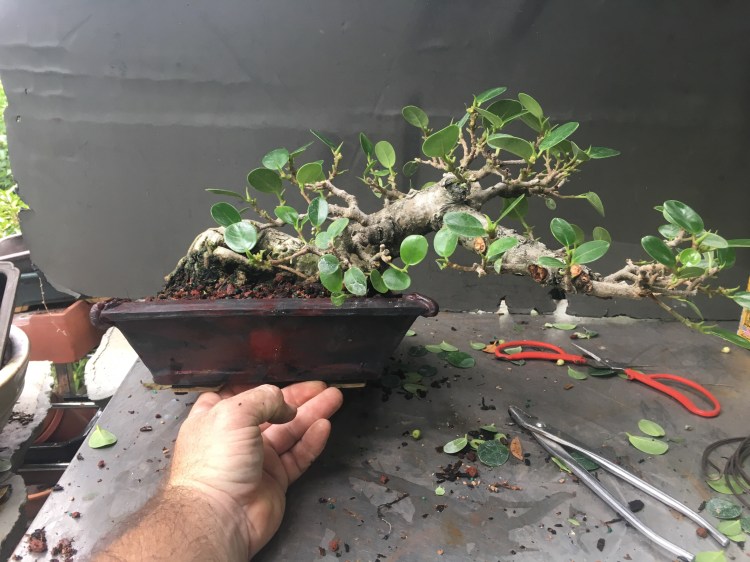 ….now I’ll get rid of some branches that are hiding the trunk.
….now I’ll get rid of some branches that are hiding the trunk.  And it’s time for the wire. Obviously there’s good movement that’s been achieved from clip and grow, but that process leaves definite straight lines.
And it’s time for the wire. Obviously there’s good movement that’s been achieved from clip and grow, but that process leaves definite straight lines. 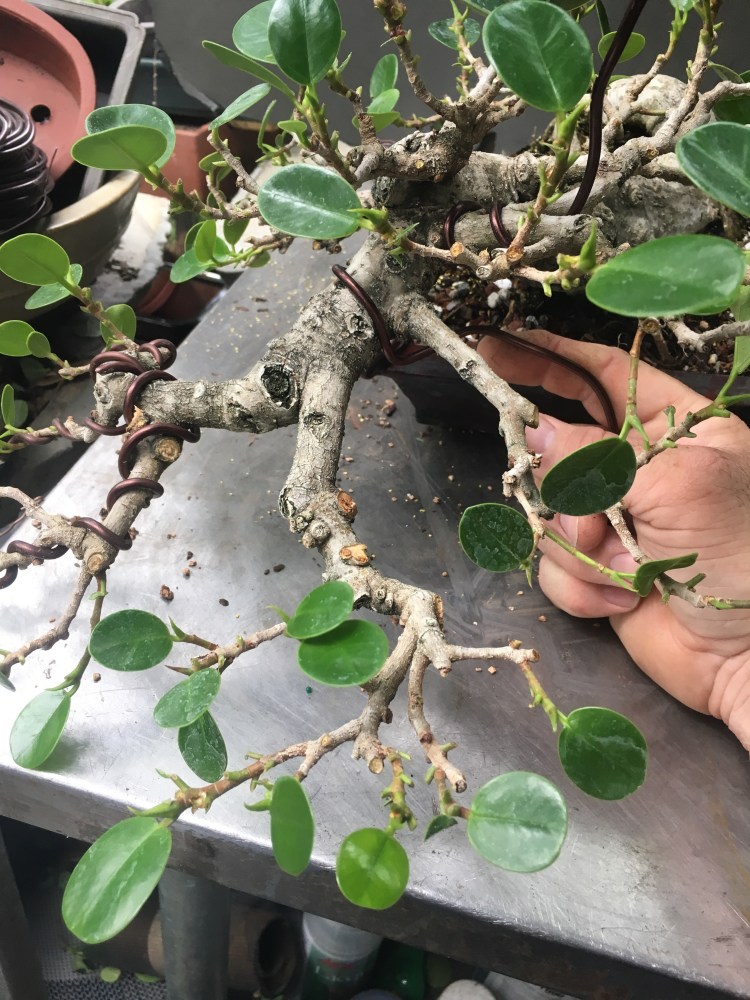 Nature abhors straight lines. Mostly. But in bonsai, straight lines often don’t look natural. Even conservative bonsai artists don’t like straight lines.
Nature abhors straight lines. Mostly. But in bonsai, straight lines often don’t look natural. Even conservative bonsai artists don’t like straight lines. 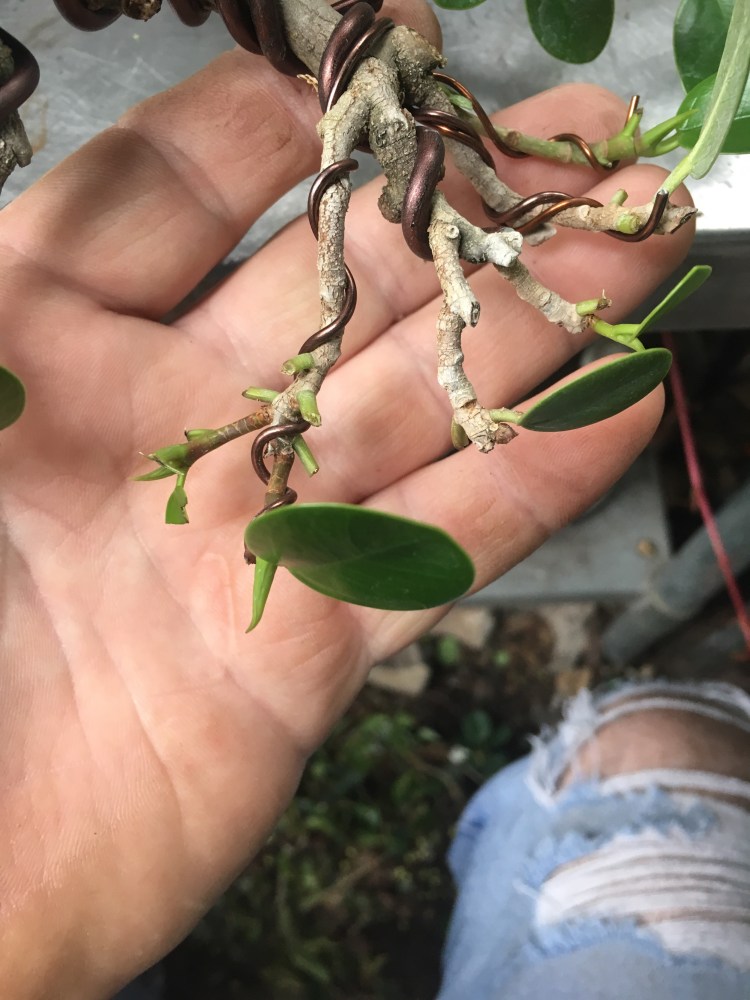 That’s where the wire comes in.
That’s where the wire comes in.  Back to the tips. Notice the leaf is now almost upside down after wiring? Those leaves will not, no matter how much you believe it to be true, give anything to the tree. It is better for the development, the health, and the structure of the tree to get rid of them. It’s a defoliation thing, ya’ dig?
Back to the tips. Notice the leaf is now almost upside down after wiring? Those leaves will not, no matter how much you believe it to be true, give anything to the tree. It is better for the development, the health, and the structure of the tree to get rid of them. It’s a defoliation thing, ya’ dig? 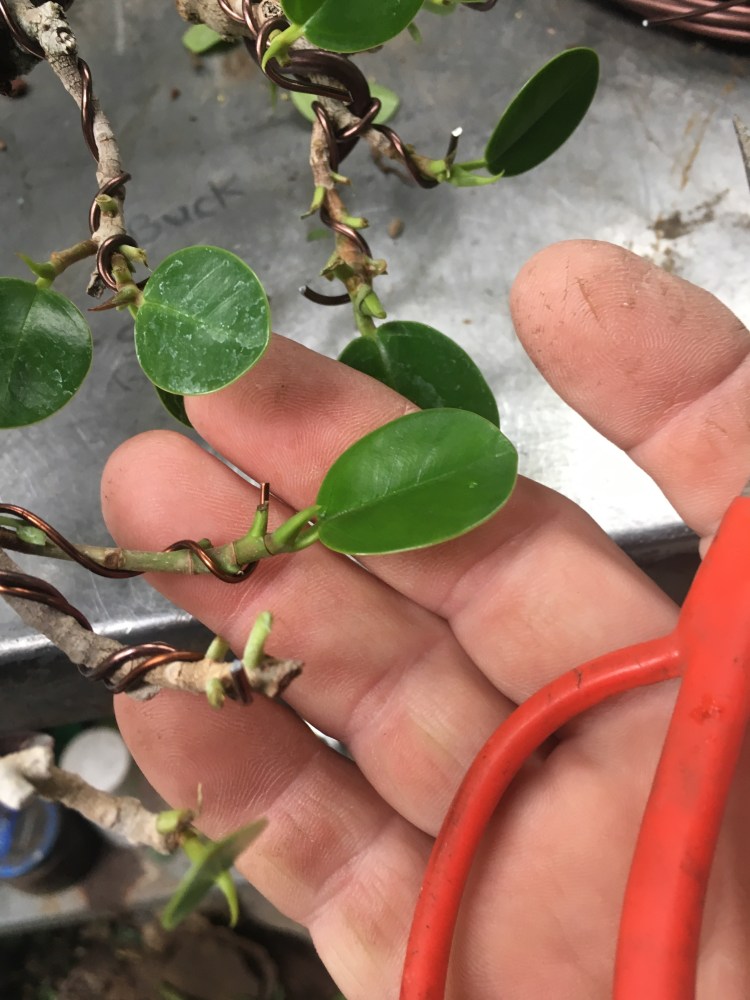 Only those leaves that are laying flat, and able to catch the sun, or can be wired into that position, are useful or even healthy to keep.
Only those leaves that are laying flat, and able to catch the sun, or can be wired into that position, are useful or even healthy to keep.  That’s another reason I remove old, discolored, and damaged leaves. It takes less energy to replace them than it is for the plant to move them or fix them. And damaged leaves can’t be fixed anyway.
That’s another reason I remove old, discolored, and damaged leaves. It takes less energy to replace them than it is for the plant to move them or fix them. And damaged leaves can’t be fixed anyway. 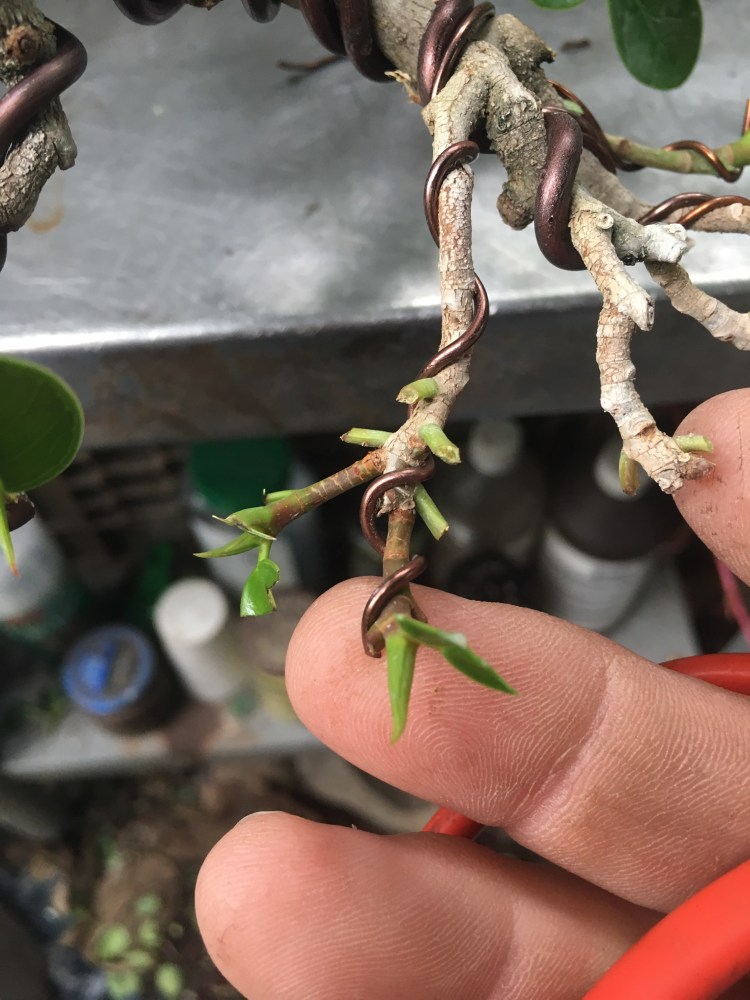 The buds are already there, the energy is allocated to grow them. Let the tree replace the old leaves with new ones. It works.
The buds are already there, the energy is allocated to grow them. Let the tree replace the old leaves with new ones. It works. 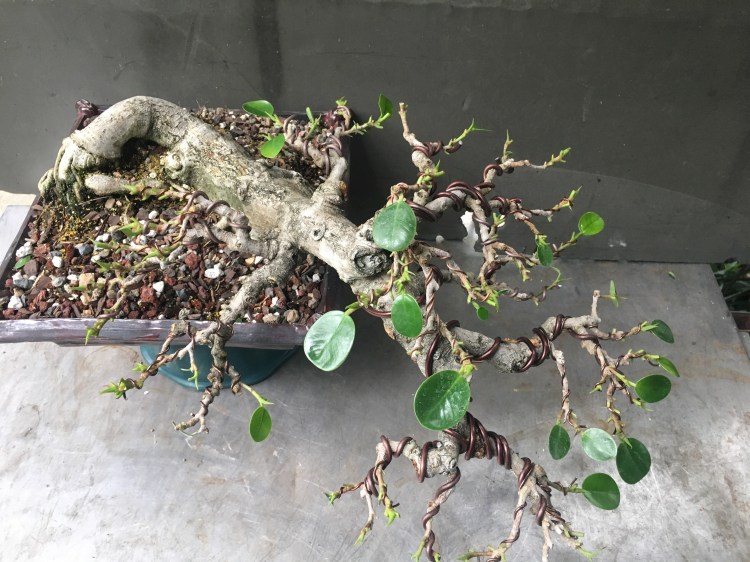 If there’s anything I’ve learned about life from my teenage kids, it’s better to work with those hormones than against them.
If there’s anything I’ve learned about life from my teenage kids, it’s better to work with those hormones than against them.
When we think of plants, and how they grow, think of the hormones as computer programs that tell the plant how to grow. It’s hard to fight the programming of the hormones, the plant will do what the hormones tell it to do, even if it kills it. That’s why it’s important to learn what the hormones do, and when, and importantly, the right time of year to perform the techniques we use in bonsai.
It is June in Florida, the ficus is growing, both in the root and crown sections of the tree.  The tree is very healthy.
The tree is very healthy. 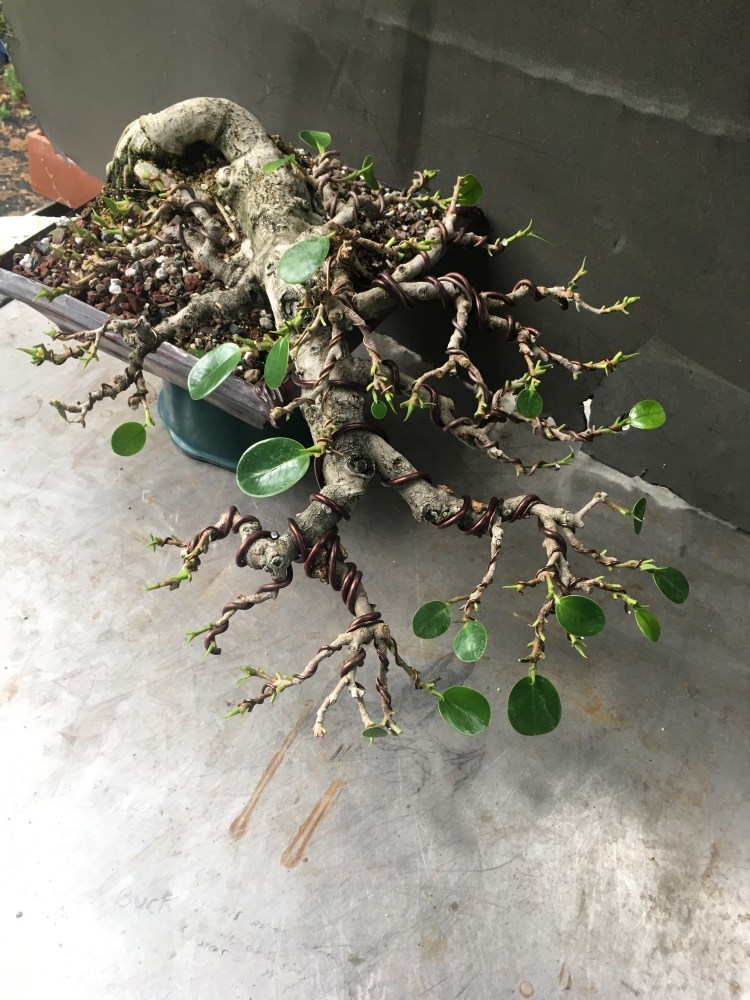 The weather has started the summer schedule, finally, which means daily rains, evening heat, humidity, and lots of daytime sun. Now is the best time to do this.
The weather has started the summer schedule, finally, which means daily rains, evening heat, humidity, and lots of daytime sun. Now is the best time to do this.
Now, I’m thinking this branch needs to go: It hides the trunk a little, but it can stay for now though.
It hides the trunk a little, but it can stay for now though. 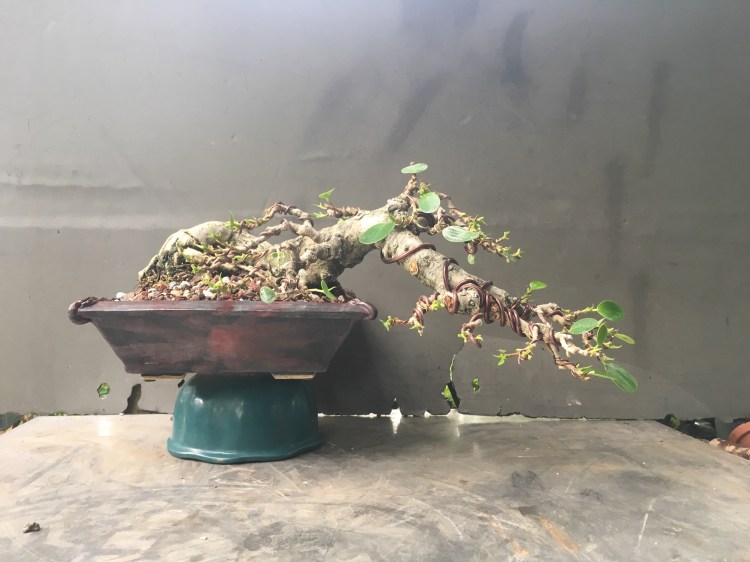
I still left many growing tips (stipules, remember?) intact because I need some elongation of some of the branches. Not to mention the tendency of this variety to abort branches. Regardless of this, what’s great about the species is the ability to reduce the size of the leaves to about the size of a dime (.705 inches and 17.91 mm). Great for bonsai. 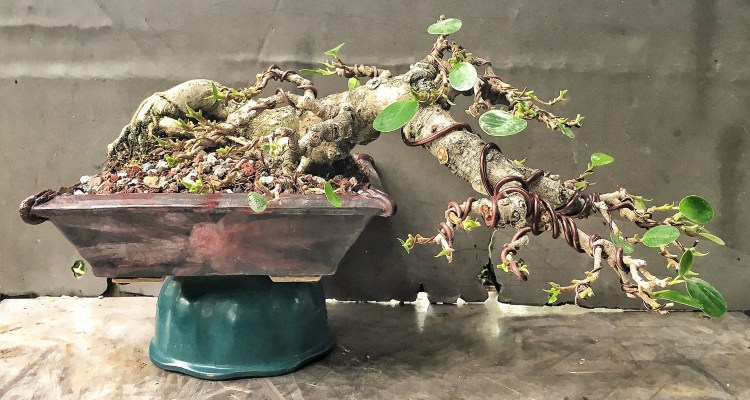 And that’s it. All the leaves are laying down, the branches are splayed out, it just needs a little more growth and then it’ll be ready for prime time.
And that’s it. All the leaves are laying down, the branches are splayed out, it just needs a little more growth and then it’ll be ready for prime time.

Enjoying your posts and pictures, So much to learn and absorb. Have been in a Bonsai club for a year, members are very generous with their knowledge. Still feel slightly uneasy about pruning and wiring but need to forge ahead, it’s the only way to learn. Can’t imagine taking care of all the trees you collectors own, but love the passion for this wonderful living art. Thanks for the knowledge you share… Robin
LikeLiked by 2 people
Good information thank you! Could you tell me the name of the tree please?
LikeLike
The tree in the article is a ficus microcarpa “green island”
LikeLike
I see “Buck” etched his name ( or her name?) on your bench there. LOL
LikeLike
Ah, that’s some notes I wrote in pencil on the bench.
LikeLiked by 1 person
That’s great gave the pic a grungy look. Love all you do and share btw man! Supporter of your approach big time! Thank you.
LikeLike
Reblogged this on Wolf's Birding and Bonsai Blog.
LikeLike
Thanks for sharing.
Have a nice day!
Amanda || http://www.organicisbeautiful.com
LikeLike